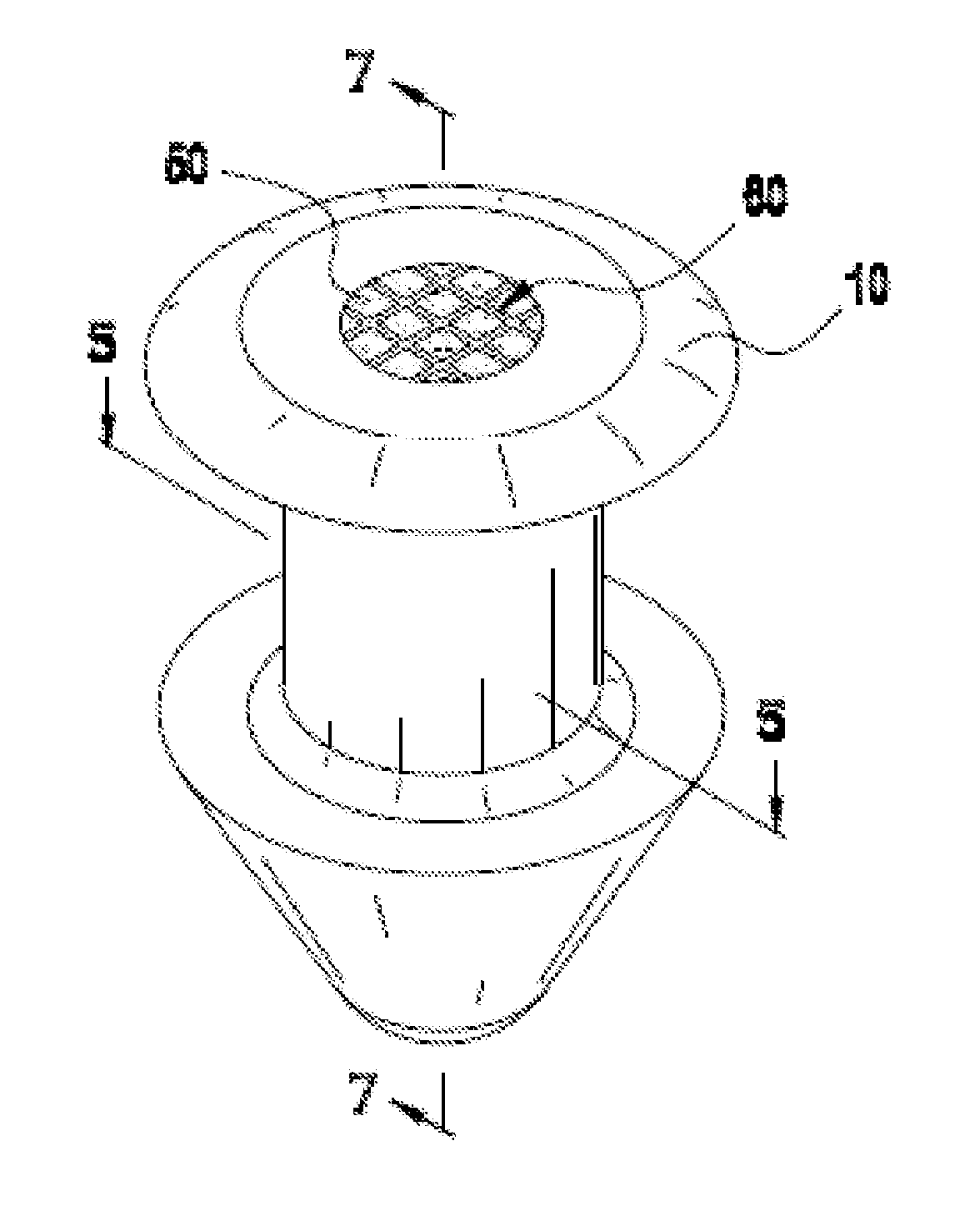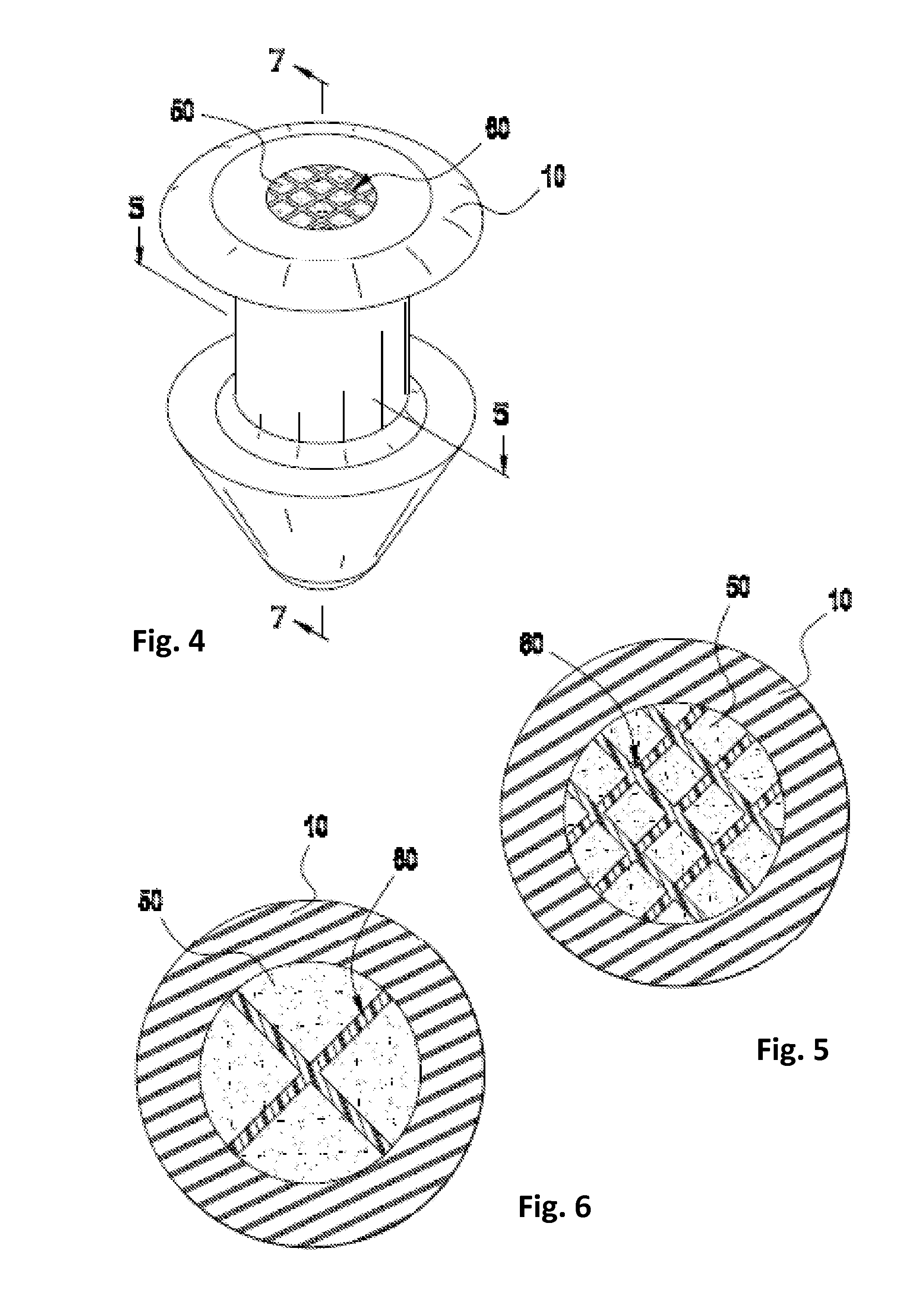Porous matrix drug core for lacrimal insert device
a technology of lacrimal inserts and drug cores, which is applied in the field of ophthalmic insert drug cores, can solve the problems of substantial drop, inefficiency, and inability to meet the needs of patients, and achieve the effect of reducing the risk of infection
- Summary
- Abstract
- Description
- Claims
- Application Information
AI Technical Summary
Problems solved by technology
Method used
Image
Examples
example 1
[0072]To create a porous matrix-containing punctal plug that is infused with the glaucoma drug latanoprost, a suitable monolith of porous polyolefin material is obtained from the Porex Corporation. The Porex material is trimmed into a disk-like object approximately a few millimeters per side, and immersed into a neat oil of latanoprost overnight.
[0073]Once visually confirming the latanoprost has fully wicked into the Porex material (changing from opaque white to slightly transparent), a 0.8 mm i.d. biopsy punch is forced into the material and withdrawn, creating an approximately 0.8 mm×1.6 mm cylindrical Drug Core comprising Porex material infused with latanoprost.
[0074]The Drug Core is then fully inserted into a 0.8 mm i.d.×1.6 mm long polyimide tube, which serves as a water and drug-impermeable barrier layer. This construct is finally inserted with tweezers into a silicone punctal plug comprising a hollow cylindrical bore sized to accommodate the drug core construct, such that the...
example 2
[0079]To create a drug-delivery punctal plug containing a drug-infused porous matrix with an increased drug payload capacity, a cylindrical piece of drug-infused Porex material is formed per Example 1, but is made significantly shorter than the length of the polyimide tube and punctal plug central cavity. Inserting the shorter Porex material flush with the bottom of the longer polyimide tube leaves an empty section of tube at the top. Neat latanoprost oil is dosed via microsyringe to fill this empty section. Finally, the filled polyimide tube is inserted into the punctal plug bore such that the end with the Porex matrix is flush with the opening of the punctal plug bore. The neat latanoprost oil is thus encapsulated and serves as an additional concentrated reservoir to replenish the adjacent porous matrix. Drug release testing per Example 1 shows a substantially similar release profile to the comparable plugs being completely filled with latanoprost-infused Porex matrix.
example 3
[0080]Drug-delivery punctal plugs containing drug-infused polytetrafluoroethylene (PTFE) porous matrix are manufactured. PTFE has several utilities relating to thermal and chemical resistance / inertness. Porex Mupor™ microporous PTFE (<30 μm pore size, ˜50% porosity) are received as sheets of 3 mm thickness. A piece of sheet is cut and submerged in neat latanoprost oil overnight. Visually, it is observed that the latanoprost fully wicks into the Porex material. A lint-free wipe is used to remove excess latanoprost on the surface of the Porex pieces. In a first set of devices, a 0.8 mm diameter rod of latanoprost-infused Porex PTFE is cut via an 0.8 mm biopsy punch and placed into a silicone cup with 0.7 mm inside diameter. In a second set of devices, a 0.5 mm diameter latanoprost-infused Porex PTFE rod is cut with a 0.5 mm biopsy punch and inserted into a punctal plug having 0.4 mm inside diameter.
[0081]Both sets of devices are immersed into 1 ml of phosphate buffered saline at pH=7....
PUM
 Login to View More
Login to View More Abstract
Description
Claims
Application Information
 Login to View More
Login to View More - R&D
- Intellectual Property
- Life Sciences
- Materials
- Tech Scout
- Unparalleled Data Quality
- Higher Quality Content
- 60% Fewer Hallucinations
Browse by: Latest US Patents, China's latest patents, Technical Efficacy Thesaurus, Application Domain, Technology Topic, Popular Technical Reports.
© 2025 PatSnap. All rights reserved.Legal|Privacy policy|Modern Slavery Act Transparency Statement|Sitemap|About US| Contact US: help@patsnap.com



